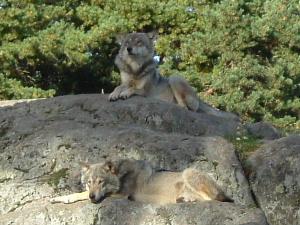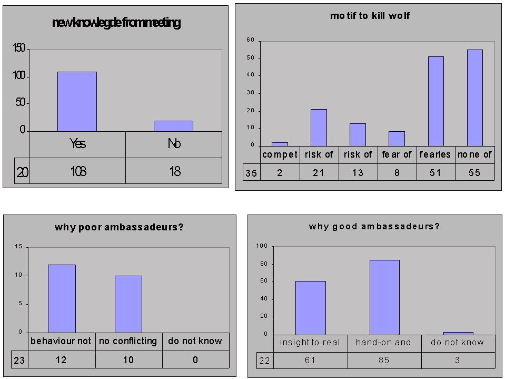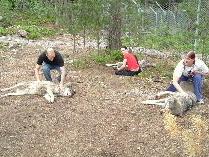Attitude survey & evaluation of hands-on meetings
Introduction to attitude survey

Human versus wolves
Although people have lived with and loved the dog, a direct descendant of the wolf, for 10000 years, the relationship with wolves has been dubious since half a century b. C. As nomadic hunters man looked to C. lupus as a role model and teacher. This changed when man in Eurasia settled down and started keeping livestock and building settlements. Then the animals became an enemy out to destroy mankind. Ever since then the wolf has been persecuted, tortured and mutilated by man. Throughout these persecutions the negative symbolism of wolves may have provided a mean to justify peoples desire to annihilate them. In both the Old and New Testament the animals are depicted as a cohort of Satan, and as an illustration of gluttony, duplicity, wantonness and sexual excess. The fables, myths, legends, stories and proverbs that features the wolf in one way or another are numerous. There are Aesopsos fables from 500 b. C depicting the wolf as cunning and devious, then there is pagan religions like Norse mythology, where the Fenrisulven devour Odin, the patriarch of Valhalla, during Ragnarök. Moreover do we have children stories like Little Red Riding hood, and proverbs, such as “ being thrown to the wolves”.
During the Middle Ages, when Christianity ruled people could even be convicted and burned, accused of being werewolves. It really was not until the Age of Enlightment, with Linneaus work, that a more objective view of the wolves were given, as apposed to the one being presented by the church. However this did not stop the negative symbolism of the wolf to spread. Just consider the fact that before Europeans arrived in America, the native Americans
respected and revered the wolf. Many hunting tribes even sought to imitate these animals’ hunting skills, endurance, and stealth. With the coming of the white man, the mass destruction and slaughter of wolves began. All over the world laws stated that wolves were to be hunted and killed, and governments began paying bounties for each wolf killed. The killing campaigns culminated with the arrival of poisons like strychnine during the end of the 19th century. With this a massive bait poisoning killed a vast number of not only wolves, but also other species. For example official numbers stat that 80730 wolves in Montana alone were killed during 1883-1918.
But are not the wolves a danger to man? Many has claimed that there never has been a reported case of a healthy wolf killing a human, but this however is not exactly true. There have been reported and verified cases of killings, like in Gysinge, Sweden during 1820-1821, or in Uttar Pradesh, India during 1996-1997. In both of these cases however the wolves had lost their innate fear of man, either because they hand been hand reared by humans (Gysinge-case) or because of habituation and close proximity to man (Uttar Pradesh-case). Then the wolves obviously had learnt to associate man with food. Other reported attacks have been those for investigational purposes, which often ends in the animal realising the object of interest is a human and then runs of.
Despite all the negative symbols, rumours and attitudes that has flourished and surrounded the wolf throughout the centuries, nowadays attitudes are beginning to turn more positive. Possibly because the knowledge of the general people is higher and we are now more aware of the need and benefits to maintain nature’s ecosystems as natural as possible. There are also preventions livestock holders can take to decrease the risk of wolves killing of their cattle which has increased the acceptance of predators for those target groups.
Like other countries were wolves are returning Sweden has since 1970s, after the wolves became protected by law, had several surveys made which investigate peoples attitudes towards wolves and other predators. In general these surveys show a correlation between experience, knowledge and acceptance. Negative experiences and ignorance lead to a lower acceptance and fear of the wolf.

Method, result & discussion
By means of a questionnaire I tried to determine whether or not the hands-on meetings between man and wolf could give the people a positive experience of the wolf, and alter negative attitudes about the species in the wild. The questionnaire consisted of 38 questions in total, questions about previous knowledge and experience, attitudes and evaluations of the meetings. Some of the questions were to be answered before the meeting took place and the rest were answered afterwards. This survey were done during January- March 2005, and included 16 groups of people, 128 respondents in total.
Of these 128 participants 75% knew before hand how many wild wolves live in Scandinavia today, and 70% felt it was very nice that wild wolves existed in Sweden. 85% were first timers at hands-on meetings, and all respondents felt their meeting had been a positive experience. 85% claimed they had learnt something new, and 92% felt the wolves were good ambassadors for their species, although 43% said the wolves felt more like dogs than wild wolves. The main motif making it acceptable to hunt and kill wolves was if the wolf acts fearless of humans and start vacating urban areas. 78% also felt that media represented the wolf wrongly, and as more dangerous than in actual life (see links for more explicit results).
On the last question, number 38, people were asked to give their own thoughts and ideas on how to improve the experience, and most of those who answered this wanted to reduce the number of participants in the group (up to 15 people at on meeting). Another common suggestion was to get some information and theory on the conditions facing the wild wolves today and how their life differs from that of the captive pack, and this before they went into the enclosure. Yet another suggestion was to have some sort of leaflet on the life history of the ambassador wolves, that people could take home as a remembrance of the experience.
Looking at the results, there were some statistically significant differences in some questions, but this was most likely due to the different amount of people in certain classification groups rather than like with the other surveys made in Sweden due to real differences in opinions depending on classification groups. The target group available during my survey was really too small and narrow to yield any differences in opinion. All were already positive towards the wolves. However since the other surveys have shown a correlation between positive experience, knowledge and higher tolerance for the wolf I would still be confident that hands-on meetings has the possibility to be a tool for conservation of wolves in the wild, particularly since the majority in my survey claimed to have learnt something new about the wolves during the meeting and because it had been a positive


Responsible for this page:
Director of undergraduate studies Biology
Last updated:
